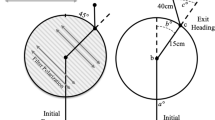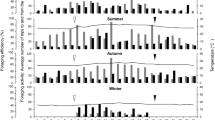Summary
The black carpenter antCamponotus pennsylvanicus (DeGeer), a predominantly nocturnal Formicine ant, responds to a hierarchy of visual and tactile cues when orienting along odor trails at night. Under illumination from moonlight or artificial light, workers rely upon these beacons to mediate phototactic orientation. In the absence of moonlight or artificial lights, ants were able to orient visually to terrestrial landmarks. In the absence of all landmarks, save for overhanging tree branches, ants could negotiate shortcuts or make directional changes in response to visual landmarks presented within the tree canopy on a moonless night. When experimental manipulations placed the ants in total darkness, they could no longer negotiate shortcuts and would resort to thigmotactic orientation along structural guidelines to reach a food source. The hierachical organization of these diverse cues in a foraging strategy is discussed, as well as their adaptive significance toC. pennsyhanicus.
Similar content being viewed by others
References
Beugnon, G. and V. Fourcassie, 1988. How do red wood ants orient during diurnal and nocturnal foraging in a three dimensional system? II. Field experiments.Ins. Soc. 35:106–124.
Collett, T. S., Dillmann, E., Giger, A. and Wehner, R., 1992. Visual landmarks and route following in desert ants.J. Comp. Physiol. (A) 170:435–442.
David, C. T. and D. L. Wood, 1980. Orientation to trails by a carpenter ant,Camponotus modoc (Hymenoptera: Formicidae), in a giant sequoia forest.Can. Entomol. 122:993–1000.
De Bruyn, G. T. and M. Kruk-De Bruin, 1972. The dirunal rhythm in a population ofFormica polyctena Furst.Ekologia Polska 20:117–127.
Duelli, P., 1972. The relation of astromenotactic and anemomenotactic orientation mechanisms in desert ants,Cataglyphis bicolor (Formicidae: Hymenoptera). In:Information Processing in the Visual Systems of Arthropods, (R. Wehner, Ed.), Springer Verlag, Berlin, pp. 281–286.
Fourcassie, V., 1991. Landmark orientation in natural situations in the red wood antFormica lugubris Zett. (Hymenoptera: Formicidae).Ethol. Ecol. Evol. 3:89–99.
Fowler, H. G. and R. B. Roberts, 1980. Foraging behavior of the carpenter ant,Camponotus pennsylvanicus (Hymenoptera: Formicidae), in New Jersey.J. Kan. Entomol. Soc. 53:295–304.
Hartwick, E. B., W. E. Friend, and C. E. Atwood, 1977. Trail-laying behavior of the carpenter ant,Camponotus pennsylvanicus.Can. Entomol. 109:129–136.
Hollander, M. and D. A. Wolfe, 1973.Nonparametric statistical methods. John Wiley & Sons, New York, 503 pp.
Hölldobler, B., 1980. Canopy orientation: a new kind of orientation in ants.Science 210:86–88.
Hölldobler, B. and R. W. Taylor, 1983. A behavioral study of the primitive antNothomyrmecia macrops Clark.Ins. Soc. 30:384–401.
Hölldobler, B. and E. O. Wilson, 1990.The Ants. Belknap Press, Cambridge, Mass, 732 pp.
Jander, R., 1957. Die optische Richtungsorientierung der Roten Waldameise (Formica rufa L.).Z. Vergl. Physiol. 40:162–238.
Kaul, R. M. and G. A. Kopteva, 1982. Night orientation of antsFormica rufa (Hymenoptera: Formicidae) upon movement on routes.Zoologichesky Zhurnal 61:1351–1358.
Klotz, J. H., 1984. Diel differences in foraging in two ant species (Hymenoptera: Formicidae).J. Kans. Entomol. Soc. 57:111–118.
Klotz, J. H., 1985. Crest-line orientation inCamponotus pennsylvanicus (DeGeer).Ins. Soc. 32:305–312.
Klotz, J. H., 1986. Topographic orientation in two species of ants (Hymenoptera:Formicidae).Ins. Soc. 34:236–251.
Klotz, J. H. and B. L. Reid, 1992. The use of spatial cues for structural guideline orientation inTapinoma sessile andCamponotus pennsylvanicus (Hymenoptera: Formicidae).J. Ins. Behav. 5:71–82.
Oliveira, P. S. and B. Hölldobler, 1989. Orientation and communication in the neotropical antOdontomachus bauri Emery (Hymenoptera: Formicidae, Ponerinae).Ethology 83:154–166.
Pricer, J. L., 1908. The life history of the carpenter ant.Biol. Bull. 14:177–218.
Rosengren, R., 1971. Route fidelity, visual memory and recruitment behavior in foraging wood ants of the genusFormica (Hymenoptera: Formicidae).Acta Zoologica Fennica 133:1–105.
Rosengren, R., 1977a. Foraging strategy of wood ants (Formica rufa group). I: Age polyethism and topographic traditions.Acta Zoologica Fennica 149:1–30.
Rosengren, R., 1977b. Foraging strategy of wood ants (Formica rufa group). II: Nocturnal orientation and diel periodicity.Acta Zoologica Fennica 150:1–30.
Santschi, F., 1923. L'orientation sidérale des fourmis, et quelque considérations sur leurs différentes possibilitites d'orientation.Memoires de la Societe Vaudoise des Sciences Naturelles 1:137–176.
SAS Institute, 1990.SAS Procedures Guide. SAS Institute, Cary, North Carolina.
Topoff, H., and K. Lawson, 1979. Orientation of the army antNeivamyrmex nigrescens: integration of chemical and tactile information.Anim. Behav. 27:429–433.
Traniello, J. F. A., 1977. Recruitment behavior, orientation, and the organization of foraging in the carpenter antCamponotus pennsylvanicus DeGeer (Hymenoptera: Formicidae).Behav. Ecol. Sociobiol. 2:61–79.
Wehner, R., 1972. Visual orientation performances of desert ants,Cataglyphis bicolor, towards astromenotactic directions and horizon landmarks. In:Proceedings AIBS Symposium Animal Orientation and Navigation (S. Galler et al., Eds.), U.S. Government Printing Office, Washington, D.C., pp. 421–436.
Wehner, R. and P. Duelli, 1971. The spatial orientation of desert antsCataglyphis bicolor, before sunrise and after sunset.Experientia 27:1364–1366.
Wehner, R. and I. Flatt, 1972. The visual orientation of desert ants,Cataglyphis bicolor, by means of terrestrial cues. In:Information Processing in the Visual Systems of Arthropods (R. Wehner, Ed.), Springer Verlag, Berlin, pp. 295–302.
Wehner, R. and F. Raber, 1979. Visual spatial memory in desert ants,Cataglyphis bicolor (Hymenoptera: Formicidae).Experientia 35:1569–1571.
Wehner, R., R. Harkness, and P. Schmid-Hempel, 1983. Foraging strategies in individually searching antsCataglyphis bicolor (Hymenoptera: Formicidae). In:Information Processing in Animals, vol. 1 (M. Lindauer, Ed.). Gustav Fischer Verlag, New York, 79 pp.
Author information
Authors and Affiliations
Rights and permissions
About this article
Cite this article
Klotz, J.H., Reid, B.L. Nocturnal orientation in the black carpenter antCamponotus pennsylvanicus (DeGeer) (Hymenoptera: Formicidae). Ins. Soc 40, 95–106 (1993). https://doi.org/10.1007/BF01338835
Received:
Revised:
Accepted:
Issue Date:
DOI: https://doi.org/10.1007/BF01338835




